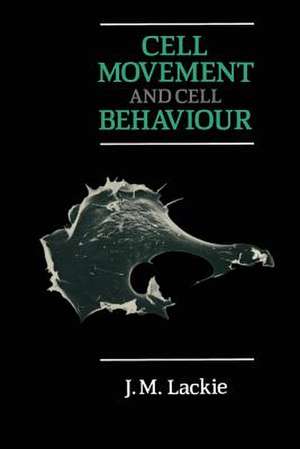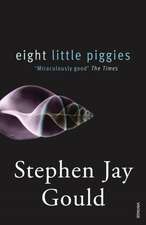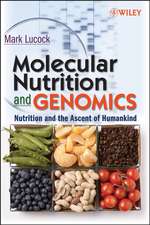Cell Movement and Cell Behaviour
Autor J.M. Lackieen Limba Engleză Paperback – 31 aug 1986
Preț: 642.36 lei
Preț vechi: 755.72 lei
-15% Nou
Puncte Express: 964
Preț estimativ în valută:
122.93€ • 128.18$ • 102.17£
122.93€ • 128.18$ • 102.17£
Carte tipărită la comandă
Livrare economică 21 martie-04 aprilie
Preluare comenzi: 021 569.72.76
Specificații
ISBN-13: 9780045740352
ISBN-10: 0045740356
Pagini: 336
Ilustrații: 336 p. 113 illus.
Dimensiuni: 155 x 235 x 18 mm
Greutate: 0.47 kg
Ediția:Softcover reprint of the original 1st ed. 1986
Editura: SPRINGER NETHERLANDS
Colecția Springer
Locul publicării:Dordrecht, Netherlands
ISBN-10: 0045740356
Pagini: 336
Ilustrații: 336 p. 113 illus.
Dimensiuni: 155 x 235 x 18 mm
Greutate: 0.47 kg
Ediția:Softcover reprint of the original 1st ed. 1986
Editura: SPRINGER NETHERLANDS
Colecția Springer
Locul publicării:Dordrecht, Netherlands
Public țintă
ResearchCuprins
1 Introduction.- 1.1 Why is movement interesting?.- 1.2 What do we mean by ‘movement’?.- 1.3 What causes movement?.- 1.4 An analogy.- 1.5 Motor design — an abstract exercise.- 1.6 How are movements controlled?.- 1.7 Which motor for the task?.- References.- 2 Motors Based on Actomyosin.- 2.1 Introduction.- 2.2 Components of the motor.- 2.3 The basic motor.- 2.4 Linear contractile systems.- 2.5 Non-linear: planar systems.- 2.6 Non-linear: solid systems.- 2.7 Control of the motor.- 2.8 Summary.- References.- 3 Motors Based on Microtubules.- 3.1 Introduction.- 3.2 Structure of microtubules.- 3.3 Dynein.- 3.4 The basic motor.- 3.5 Cilia and flagella.- 3.6 Movement in the mitotic spindle.- 3.7 Movement associated with cytoplasmic microtubules.- 3.8 Summary.- References.- 4 Motors of Other Sorts.- 4.1 Introduction.- 4.2 Bacterial flagella.- 4.3 Other bacterial motors.- 4.4 The spasmoneme of vorticellids.- 4.5 Assembly-disassembly motors.- 4.6 Hydraulic systems.- 4.7 Miscellaneous motor systems.- 4.8 Summary.- References.- 5 Swimming.- 5.1 General.- 5.2 Swimming.- 5.3 Methods of obtaining forward thrust.- 5.4 Control of the direction of ciliary beat.- 5.5 Summary.- References.- 6 Crawling Movement.- 6.1 Introduction.- 6.2 A simplistic analysis of the problem.- 6.3 Amoeba.- 6.4 Fibroblast locomotion.- 6.5 Fibroblast spreading.- 6.6 Movement of other cell types.- 6.7 Summary.- References.- 7 Moving in a Uniform Environment.- 7.1 Introduction.- 7.2 Random walks and internal bias.- 7.3 Effects of changes in environmental properties.- 7.4 Roughness.- 7.5 Rigidity and deformability.- 7.6 Summary.- References.- 8 Anisotropic Environments.- 8.1 General.- 8.2 Trapping and avoidance.- 8.3 Gradients.- 8.4 Flow.- 8.5 Magnetic and electric fields.- 8.6 Gravity.- 8.7 Shape.- 8.8Rigidity.- 8.9 Summary.- References.- 9 Chemotaxis.- 9.1 General.- 9.2 The problem - a theoretical analysis.- 9.3 Bacterial Chemotaxis.- 9.4 Chemotaxis in Paramoecium.- 9.5 Chemotaxis in the cellular slime-moulds.- 9.6 Chemotaxis in Myxobacteria.- 9.7 Chemotaxis of leucocytes.- 9.8 Summary.- References.- 10 Cell-Cell Interactions.- 10.1 Introduction.- 10.2 Contact inhibition of locomotion.- 10.3 Consequences of contact inhibition.- 10.4 Escape from normal contact inhibition.- 10.5 Invasiveness as a general phenomenon.- 10.6 Summary.- References.
Recenzii
The book is written in a friendly disarming style that should carry along those newcomers to the field...As an introduction to cell and molecular biologists wishing to understand more about the movements of living cells the book has no parallel. - The Times Higher Education Supplement
















